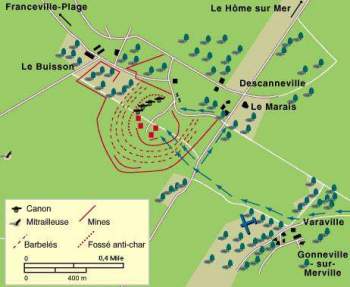
The Merville battery is located on the east
bank of the mouth of the river Orne.
Night
of June 6th 1944 Just after 2300
hours on June 5th, the first "Albermale" carrying the pathfinders of
the 9th battalion, parachute regiment, took off from England for the French coast.
Their mission : one part was to jump on the DZ "V"' so as to prepare
the meeting of the battalion, whereas the other group were to go to the battery
of Merville to make a reconnaissance and to clear a way through the mine fields
to allow the attack of the battery by the battalion.
At 0020 hour on June
6th, the first paratroopers jumped over France. A high wind, bad atmospheric conditions
and the german Flak, forced the "Albermale" pilots to undertake evasive
manoeuvres, so that the pathfinders were dispersed around the area of the DZ "V".
About ten landed on the DZ and the pathfinders were able to mark it with the only
two markers left. The reconnaissance group landed on the DZ correctly and made
their way to the battery. At 0030 hour a wave of 100 heavy bombers started to
shell the battery, not to destroy the blockhouses which seemed impossible, but
above all to explode as many mines as possible around the battery. The bad weather
also hindered the bombers so that they missed their target, The bombs fell amongst
the group of paratroopers, terrorised but luckily unscathed. The first part of
the plan of lieutenant colonel Terence OTWAY had failed. At
0045 hour thirty two Dakota's arrived to undertake the dropping of the 9th battalion.
Once more the bad visibility, the wind and the german Flak prevented the normal
procedure of the operation. Some planes missed the dropping zone and circled to
find it again, The others dropped the paratroopers at random. Some landed in the
marshes or the meadows flooded by the river Dives : They were either drowned or
floundering for very long hours trying to find a way out of this trap.
Lieutenant colonel T.OTWAY only arrived
at the meeting point at 0200 hours. To find only one hundred men present
out of the seven hundred fifty expected. Also as the gliders carrying
the heavy material had not arrived, the anti-tank guns, the flame throwers,
the jeeps, the "Bangalore" torpedos, the mine detectors, the
mortars and the aluminium ladders had to be done without. They had at
their disposal just one heavy Vickers machine gun and some "Bangalore"
torpedos. At 0245 hours the group started off for the battery after having
rounded up fifty men. They were going to attempt an attack with 150 instead
of the 750 men initially anticipated.
 On
the way Lieutenant colonel T.OTWAY met up with Major George SMITH who gave a report
on the reconnaissance done up to the battery; breaches had been cut through the
first barbed wire network. A passage had been made through the mines field by
using their bayonets and the few "Bangalore" torpedos were in place
under the second barbed wire network. During this time OTWAY's men holed up in
ditches, shell holes or along hedges waiting for the order to attack. On
the way Lieutenant colonel T.OTWAY met up with Major George SMITH who gave a report
on the reconnaissance done up to the battery; breaches had been cut through the
first barbed wire network. A passage had been made through the mines field by
using their bayonets and the few "Bangalore" torpedos were in place
under the second barbed wire network. During this time OTWAY's men holed up in
ditches, shell holes or along hedges waiting for the order to attack.
During
the final attack, three gliders were to land directly on the battery after having
received a special signal: a luminous bomb fired by a mortar. But OTWAY had neither
mortar, nor luminous bomb. Two gliders
arrived at the given time, the third having been forced to turn back and land
in england. The planes released them and the pilots began to look for the luminous
signal. OTWAY and his men watched them without being able to do anything. The
first glider headed for the village of Gonneville which was on fire and landed
6 kilometers further on. The second circled over the battery, was caught in the
german Flak and crashed in a forest 500 meters farther. Lieutenant
colonel T.OTWAY then gave the order to attack. Men rushed forward in two groups
to take the battery. The fighting was intense and after fierce hand to hand combat,
the german garnison surrendered. Only 75 men of the battalion survived. For the
germans the battle had been worse: out of the 200 men of the garnison, only 22
survived. At 0445 hours Lieutenant colonel
T.OTWAY then fired a yellow rocket, a sign of successful mission. At the same
time his communications officer sent confirmation by carrier pigeon; The bird
had been with the officer throughout.
The four german guns had been put out
of action. However these were not the 150 mm guns as anticipated but 100mm guns
which were able to reach the different sectors of Sword Beach. Despite
heavy losses, the men of the 9th Para Battalion had successfully accomplished
their mission. |